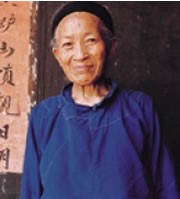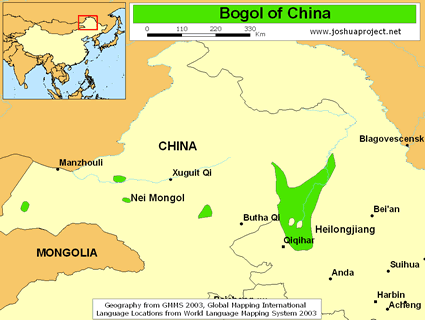The Bogol are the descendants of former slaves of the Daur people. Although they became free in 1908, thre are still social and ethnic barriers between the Bogol and Daur. The Daur refuse to intermarry with the Bogol, who have built their own village and developed their own identity. The Bogol do not speak their own distinct language; however, a people group has been defined as "a significantly large ethnic or sociological grouping of individuals who perceive themselves to have a common affinity for one another."
In the past the Daur social structure was unique, "being made up of pedigree families, the commoners and the Bogol (reputed to be slaves). The Bogol were comprised from two groups. One group was made up of the descendants of Bardachi who had rebelled against the Qing Dynasty (1644-1911). It ordered that members of the rebelling clan should remain slaves from generation to generation evermore. The second group was made up of the descendants of prisoners-of-war brought in by the Daur army during the Taiping Rebellion. The Daur consider these slaves as members of their own families. They were likely servants. While intermarriage was forbidden, they lacked for nothing in life. In 1908, the slaves of the Daur became free, after which they established a village at the Shiwalt of the Morindawa. Even today intermarriage between the two remains very rare."
The Bogol observe more Chinese traditions than do the Daur. They enthusiastically celebrate the annual Chinese New Year and Spring festivals.
The Bogol believe they must placate a complex collection of gods in order to live prosperously. They have 24 spirits represented by a colored painting and huge wooden images.
Although they were liberated from physical slavery 90 years ago, the Bogol remain in spiritual slavery to the spirit world. Few have ever heard of Jesus Christ or his victory over the powers of darkness that still bind them. There are no known Christ followers among the Bogol.
The Bogol people need to submit to Jesus Christ so they can experience the abundant life he offers them in John 10:10.
Pray for bold workers who are driven by the love of the Holy Spirit to go to them.
Pray for an unstoppable movement to Christ among them.
Pray for the authority of Christ to bind hindering spiritual forces to lead them from darkness to light.
Pray for signs and wonders to happen among them and for great breakthroughs with a rapid multiplication of disciples and house churches.
Scripture Prayers for the Bogol in China.
Operation China, Asia Harvest, Copyrighted © Used with permission
| Profile Source: Joshua Project |











